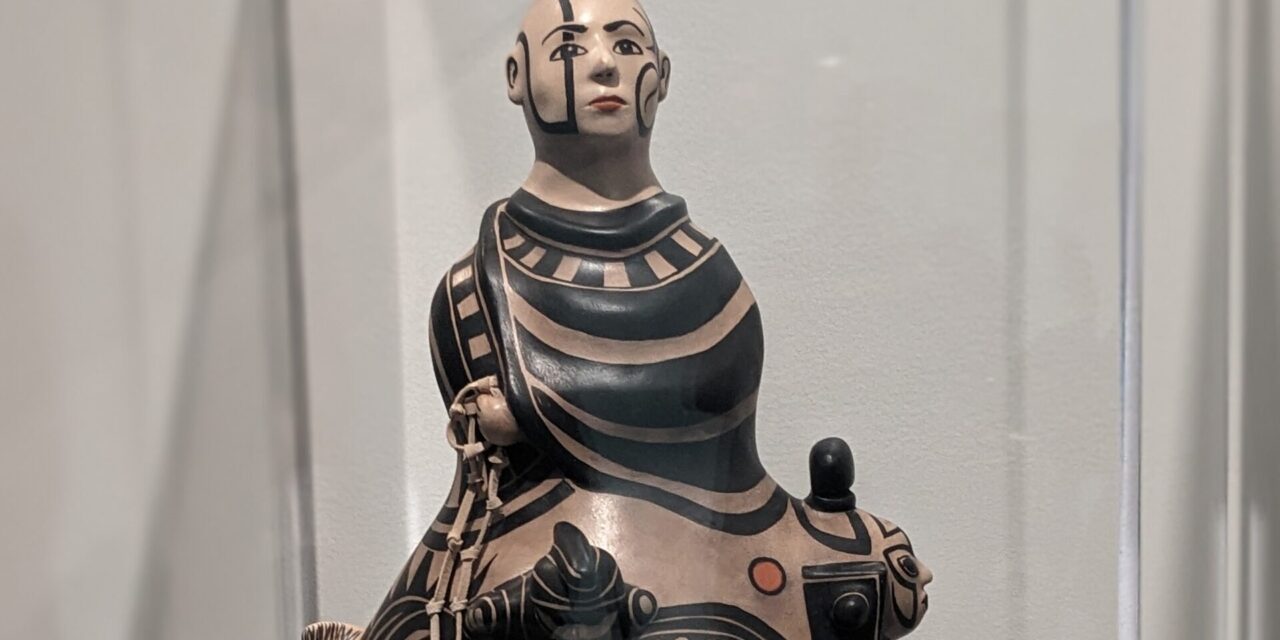RALEIGH, NC – The North Carolina Art Museum’s newest exhibit opens March 2nd, making history as the first exhibition of such a nationwide scope since 1989. To Take Shape and Meaning: Form and Design in Contemporary American Indian Art features 75 contemporary Indigenous artists from 50 tribes across the county in over 90 three-dimensional works – and 8 of these artists are from North Carolina. Ranging from traditional clay and weaving techniques to custom cars and high fashion collections, the pieces in this collection are as unique and varied as the artists who created them, but revolve around 5 central themes of Native American identity: encoded commentary, place of being, rootedness, genealogy, and revival and exploration.
Guest curator Nancy Strickland Fields, who has Lumbee heritage and works at UNC-Pembroke’s Museum of the Southeast American Indian, spoke at the NCMA’s Spring Media Day about this exhibition in particular. It was inspired, Fields said, by a single piece of pottery she saw on display in rural NC; a large vessel dated back to the 700s C.E inspired awe but also a host of unanswered questions. Who taught you how to do this? she wondered. What was happening around you? So often, Native American artworks are presented in archeological and historical contexts, but in an age of cultural reclamation begun with laws like the Native American Graves Protection and Repatriation Act of 1990 (NAGPRA) and thrust into public attention by the Black Lives Matter movement and the subsequent national reckonings occurring since 2020, more and more institutions are reexamining both the ownership of Native artifacts and art, as well as their role in showcasing both historical and contemporary Native identity.
“For every [Native] artist you see,” said Fields, “there are thousands more, and thousands who came before them,” and the exhibition explores this shared history in a way that honors the past but very actively propels the conversation into the present and future.
I had the privilege to walk through the exhibition as part of the media preview, and chose a couple of works to highlight. This list doesn’t come close to exploring the full scope of media, themes, or ideas represented – I didn’t have the chance for a slow, deliberate walkthrough, but did get to hear from a few of the featured artists.
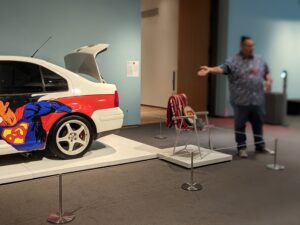
Tom Farris with his “Shifting Paradigms” installation

Tom Farris’ “Shifting Paradigms”: the “Cherokee Superman” vehicle
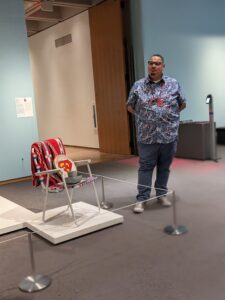
Tom Farris speaking on “Shifting Paradigms”
Tom Farris spoke on his installation Shifting Paradigms, which appears front and center at the entrance to the exhibition. His “Cherokee Superman” is painted on the side of custom car that is outfitted with all kinds of nods life as a member of the Cherokee Nation and the Otoe-Missouria Tribe. The trunk is constructed of cedar, reminiscent of the cedar chests used to store and protect important tribal regalia, the “gun rack” houses a war club outfitted in the style of a classic Southern rifle stock, and the car totes a folding chair, handmade blanket, hand drum, and eating utensils to represent the rich tradition of outdoor dining, get-togethers, and music-making. As an installation it is striking, and the love and attention put into every detail during the two-year process (from car restoration and rebuilding to detailing and accessorizing) is reminiscent of the principle Farris describes as “using every part of the buffalo,” so to speak.

Vincent Ortiz with his work
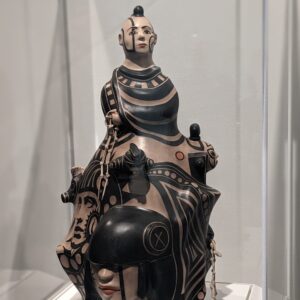
Vincent Ortiz’s “Convergence”
Virgil Ortiz whose clay work is photographed in the featured artwork of the exhibition, similarly addresses old ideas presented with a new spin. His piece Convergence, Defenders Descend from Portal to Pueblo was created in the traditional style, from hand-digging the clay to painstakingly building up framing for the firing process, but actually represents characters from an upcoming feature film he is creating. The over 19 characters he has created were directly inspired by the 1680 Pueblo revolt, America’s first and underrepresented revolution, and the film’s story will interweave this forgotten history with time travel between present-day and 2180 as it explores what happened to the original Pueblo peoples. His works reflect his Cochiti Pueblo heritage, even including costume designs for use in the film, but, he says, “the heart and soul” of his work is in his clay.

Harlen Chavis, Jr. speaking in front of his “Mississippian Gorget”
Harlen Chavis Jr., who is a Lumbee artist with a special interest in archaeology, has created the Mississippian Gorget out of found and recycled materials that connect in surprisingly historical ways. The copper used for the base was recycled from a construction site, and he spoke briefly on themes of recycled and recreated materials, and how Indigenous people in particular have internal broken pieces that can be metaphorically healed as they work with the physical broken and old objects. Copper was widely traded by the Lumbee of old, and Chavis sought to create the gorget out of this historically important material, but needed to find suitable stone for the detailing. Research and excavation of several sand mounds in “Lumbee-land” discovered in the 1800s yielded interesting finds, including red ochre, which, coincidentally enough, was historically traded for copper. Not only is the piece deeply symbolic, but it is richly beautiful.
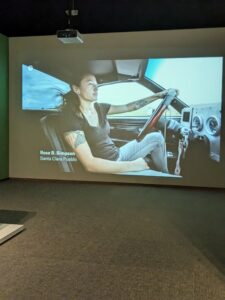
Rose B. Simpson inside her El Camino – part of the video paired with her installation
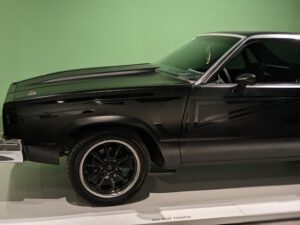
Rose B. Simpson’s “Maria”

An example of Maria Martinez’s pottery, on display next to Simpson’s “Maria”
While I didn’t get to hear from her directly, artist Rose B. Simpson of the is also featured in the exhibition with her work, Maria, and visitors will have the opportunity to engage with a video interviewing Simpson that gives a closer look at her process. Maria is the second car in the exhibition, a custom El Camino painted in homage to the striking pottery of Maria Martinez (1887-1980). Martinez, herself from the San Ildefonso Pueblo tribe, is credited with reviving the black-on-black technique discovered in ancient Pueblo excavations in New Mexico’s Pajarito Plateau region. There’s more to the story, of course, than the cosmetic similarities, but visitors will have to explore the installation and Simpson’s video to learn more.
On Saturday, March 2, the Museum will celebrate the opening of To Take Shape and Meaning with the NC Indigenous Artist Festival and free admission to the exhibition. Community Days, which include special programming and free admission to the exhibit, will occur on Saturday, April 20; Sunday, May 19; Sunday, June 16; and Sunday, July 21, from 10 am to 5 pm.
To Take Shape and Meaning runs from March 2 – July 28, 2024, and is free for members, college students, and children 6 and under. Tickets start at $14 for youth ages 7-18, $17 for seniors 65+, and $20 for adults.
Exhibition programming details include:
Artist Panel: Indigenous Understanding of Shape and Meaning in American Indian Art
Friday, March 1, noon–1 pm
Free with registration
Join us for a discussion moderated by guest curator Nancy Strickland Fields (Lumbee) with renowned artists Kenneth Johnson (Muscogee/Seminole), Virgil Ortiz (Cochiti Pueblo), and Margaret Roach Wheeler (Chickasaw/Choctaw).
NC Indigenous Artist Festival
Saturday, March 2, 10 am–4 pm
Free, including free admission to To Take Shape and Meaning
Celebrate Indigenous arts and culture from across the state of North Carolina, meet artists and buy traditional crafts and contemporary jewelry, and drop in for free workshops and a performance by Lumbee culture dancers.
Meet the Curator: Nancy Strickland Fields
Free on Community Days: Saturday, March 2, April 20, 1–2 pm
Free with ticket to the exhibition (must register): Saturday, May 18, June 8, 1–2 pm
Meet Nancy Strickland Fields, director/curator of the Museum of the Southeast American Indian and guest curator of this celebration of contemporary Indigenous art, who leads a tour of To Take Shape and Meaning.

